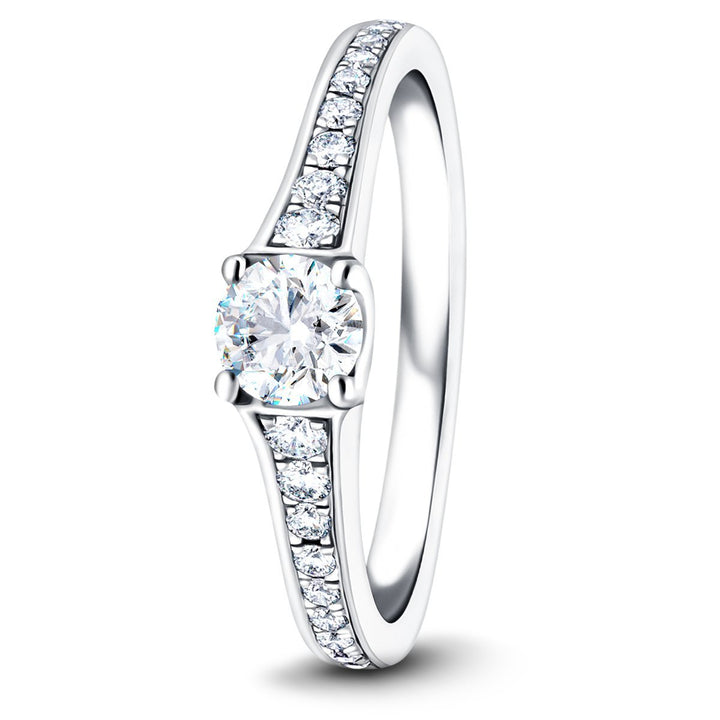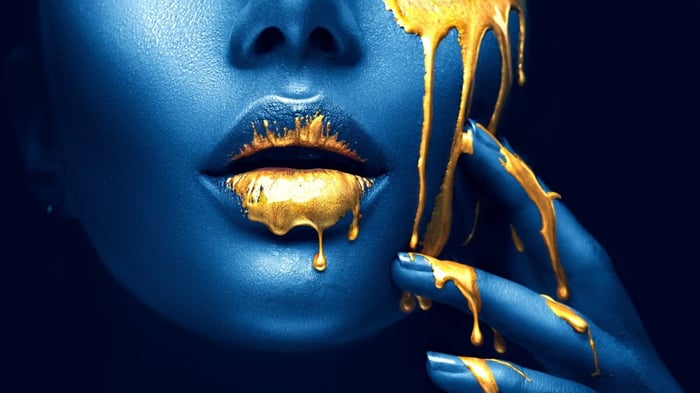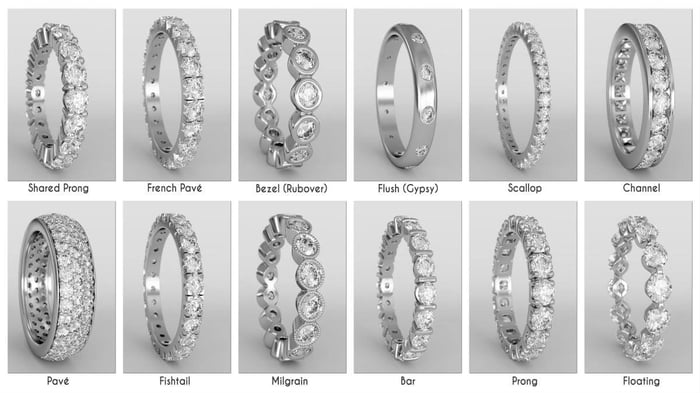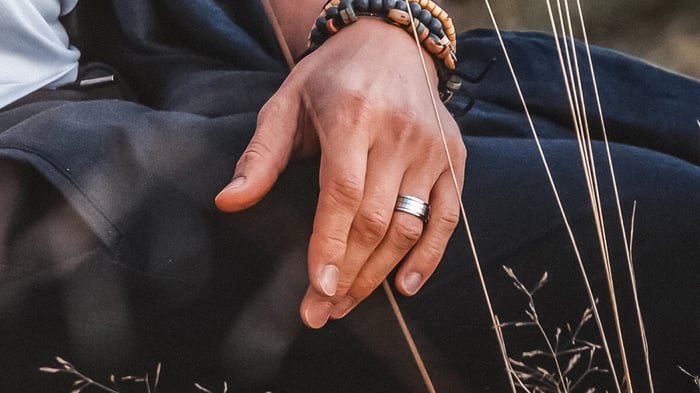White Gold, Yellow Gold, Platinum - Which Precious Metals Should You Choose?
Whether you are shopping for an engagement ring on your own, with a friend or even your fiancee, choosing the right engagement ring can be a stressful experience. With so many choices regarding the array of styles, the types and sizes of diamonds and even the choice of precious metals to use in the ring, there's almost certainly much more going on than you ever expected!
The type of precious metal you choose can significantly impact the ring's durability, how much it will cost, the style of ring you choose, and, of course, how it will suit your partner's taste and even skin tone. In most cases, the engagement ring will also set the tone for the rings you choose to exchange on your wedding day.
Many types of precious metals are used in engagement rings ranging from stainless steel, through silver, platinum, and titanium. We will concentrate upon just two, gold and platinum. They are a durable and cost-effective option for most couples. We do not recommend choosing other metals for engagement rings. That's because, between them, all of the typical colours are available.
For quite a few years, platinum has been very popular for engagement rings. Still, gold has been making something of a comeback as couples want to choose a ring that can stand out a little. Gold is an excellent choice for an engagement ring because of the wide range of colours in which it is available, including white, yellow and rose. There is a lot of choice when it comes to gold, and even within a colour grade such as rose gold, the depth of the colour can vary from light, almost pink tones to deeper reddish or orange tones.
Yellow Gold Engagement Rings
Gold has been the precious metal of choice for thousands of years. It never rusts or oxidises and is easy for goldsmiths to work with it. When the modern engagement ring really came into vogue during the Victorian era, yellow gold was the metal of choice for almost all engagement rings. Everyone recognised the rich lustre of gold. Nothing else came close in terms of its perception among couples - and not just for engagement rings but all types of jewellery. Since the start of the 21st century, yellow gold fell slightly out of favour. Couples preferred the shimmering white colour of platinum and even titanium's grey sheen. In recent years the pendulum is swinging back in favour of classic yellow gold for engagement rings. This is not a form of nostalgia; it reflects the work that jewellery designers have done working with the yellow metal in innovative ways and a general trend away from stark, cold design towards warmth. Yellow gold is undoubtedly worthy of consideration for your own engagement ring choice!
White Gold Engagement Rings
At the beginning of the 20th century, jewellers found ways to work with platinum on a small enough scale to use in jewellery. Women loved the cool fire that the white-on-white effect of diamonds on shimmering platinum making it a very fashionable choice during the first few decades of the 20th century. White gold was always seen as a pleasing alternative to platinum during this period. It remained so throughout the Art Deco years.
White gold was, and is, loved for the gleaming white that can enhance the sparkle of the white diamonds set into it. White gold makes a lovely complement to the cold fire of any number of diamonds set into an engagement ring.
Many people confuse white gold with platinum or even silver at first glance. Still, white gold has its own look and has its own benefits separate from both silver and gold. Silver is too soft to be used in fine jewellery designed to last a lifetime. Of course, silver oxidises, meaning that it loses its shine and must be polished.
Platinum is more costly than white gold, is harder to work with and is more prone to scratches than gold alloys. Platinum will usually need to be repolished from time to time to retain its good looks.
White gold confuses many people - it's the wrong colour. The silvery-white colour is due to the combination of metals alloyed (mixed) with yellow gold. After the ring is made, it is coated with rhodium, a white metal similar to platinum. The rhodium coating enhances the whiteness of white gold. Unfortunately, the rhodium coating can wear off over time. Every decade or so, the coating needs to be renewed by a jeweller. This treatment restores the metal to its 'as new' colour and shine.
Rose Gold Engagement Rings
Rose gold is an alloy of gold with copper. The exact shade of the gold depends upon how much copper is added to the mixture. You will see rose gold in shades ranging from a light pink shade to a ruddy, almost orange colour. While rose gold has become much more prevalent in fine jewellery over the past couple of decades, it is still an unusual choice for engagement or wedding rings. However, we do have some engagement rings in Rose gold, so please check them out!
Coloured Gemstones And Metal Colour
Another area where the colour of the metal is important is when the ring has gemstones that are coloured, either with diamonds or not. Both yellow and white metals can look great with coloured gemstones. The trend for coloured gemstones in diamond engagement rings shows no sign of slowing down. Your choice of colour for the precious metal is, in the final analysis, one of personal choice. Here at All Diamond, we make most of our designs in at least two colours and often three.
Anillo de compromiso de diamantes con montura de hombro certificada de 0,50 ct G/SI en platino

€1.580,95
Este hermoso anillo de diamantes es la máxima expresión del amor. Úselo como el anillo de compromiso perfecto para su persona especial. Este impresionante anillo está hecho con los mejores materiales en el Reino Unido para brindarle una vida llena… read more
Gold Weight And Purity
The purity of gold is measured in Karats, with 24 Karat gold being pure gold and lower Karats, such as 18 or 9k, having less gold in the ring's metal. The lower the Karat rating, the less the gold should cost. The weight of gold is expressed in grams. The heavier the gold ring, the more it will cost, so a chunky 18K 5mm wide gold band will cost significantly more than a slender 1.7mm band of equal gold purity. When you buy jewellery in the UK, look for a hallmark stamped into the metal. If there is no hallmark, then the chances are that the metal is not what you have been told it is.
All colours of gold are less expensive than platinum; however, platinum has a unique sheen that many people love. Platinum is also less susceptible to major damage as it is harder than gold. Still, it is more easily scratched, leading to a need for repolishing from time to time.
Match Your Wedding Ring To Your Engagement Ring
Many women prefer to match their wedding ring with their engagement ring. If you are one of those people, then take care to buy both rings of the same colour and type of precious metal. On the other hand, it is becoming popular to use contrasting colours, such as yellow gold with platinum or white gold.
Will you always love that contrasting (clashing) colour pairing?
Of course, choosing which precious metal to choose will come down to your preferences and the budget you have set for buying the engagement ring. Whichever way you go, bear in mind that this is a choice that you will live with for many years, perhaps a lifetime. To get personal advice about buying the right engagement ring for you and your fiancée, click the online chat box in the bottom right-hand corner of this page.
To learn more about different precious metals, please check out our articles on the subject here and here.




